
What is it all about?
Bablic completely automates the website localization process. You can turn your mono-lingual website into a multi-lingual one by simply pasting a code snippet in the site.
Bablic works with any website and requires no programming, no project management and no alteration to the website's existing CMS system.
Video
Video & screenshots
screenshots
Who is it for?
Key Features
- User-friendly editor to translate or review content manually. Content QA on the fly! - Replace images for each language to customize website appearance to target audience - Super-easy interface to adjust layout and CSS. No more broken layout because of longer words! - Add collaborators to work on your website - Get real-time quotes and send pages to professional translation with one click - Quick Import/Export of content - Automatic translation of all updates and changes. All languages on your website are always up to date!
Benefits
The entire localization of your website requires minutes. Literally. And it costs a fraction of what you thought. - No need for programming - No need for project management or dedicated resources - No need for CMS expansion - No implementation time. Translation is live on website as soon as it is completed. You can reach your customers worldwide within 24-48 hours depending on translation volume
Pricing
Description
Bablic has a FREE plan that you can activate without registering a credit card. If you like it you can subscribe to one of our monthly packages (or yearly, and get a discount!) Professional translations are paid separately and on-demand.
Integrates With

Product Analysis
Bablic Review – An Easy and Cost-Effective Solution for Website Localization
How can we get more traffic and engagement? How can we increase sales, leads and customers? How can we gain a competitive advantage? How do we lower advertising costs? Which opportunities are we missing?
Every company with a marketing strategy has asked these questions, and if your product or service relates globally, you’ve probably had the localization discussion at least once.
As products and services become deliverable around the globe, reaching new audiences and speaking to new markets is becoming more of a necessity than a luxury.
However, localizing a product or service requires so much more than language translation. Once there are eyes on your site, you need ask yourself these questions: does my content relate? Do my visuals, case studies and calls to action speak to my new market?
You must consider time zones, currency, national holidays, local color sensitivities, product or service names, gender roles, and geographic examples. A truly localized service or product speaks to a different culture as if it belonged to that culture. Let’s call that having a conversation on your customers’ terms.
However, what can lead to thousands in increased revenue down the line requires a heftyinvestment up front (think expertise, manpower, and resources).
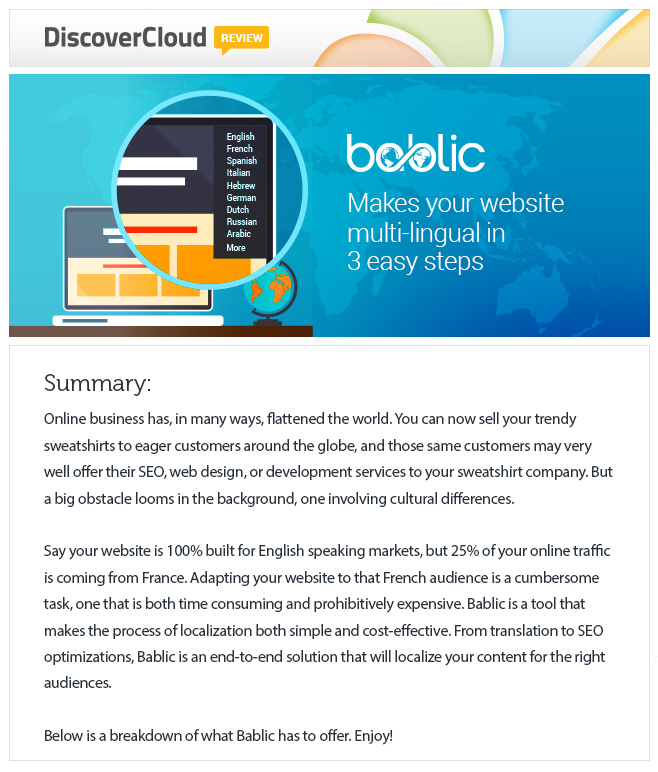
Enter Bablic.
Targeted at small business owners (SMBs), Bablic aims to make localization accessible by simplifying the entire localization process from design to translation to search engine friendly URLs. As a one-stop affordable shop for localization, Bablic greatly reduces the need for a team of web designers, programmers, SEO experts and translators, all while dramatically decreasing the cost of having a multi-lingual website.
Bablic’s capabilities go beyond serving SMBs – its ease of use and convenient multi-user, multi-project dashboard makes it a perfect tool for freelance translators, agencies and web designers.
Bablic is serious about the localization game and passionate about it as a revenue and business strategy game-changer. Their blog (an excellent – and FREE- resource if you’re not yet convinced localization is the way to go or know where to begin) cites an article from Harvard Business Review that claims 56.2% of consumers say that the ability to obtain information in their own language is more important than price. Localization is essential and Bablic lowers that barrier to global entry.
Below, we take you step-by-step through Bablic’s many features and customization options.
Bablic’s Overall User Interface & User Experience
A Technical Note: Do I need to be a “techy”? No!
Bablic is pretty intuitive even for those with absolutely no technical knowledge, which is often the biggest deterrent for small businesses wanting to make big changes.
All of the changes – from translation to style editing – can be made from within Bablic’s intuitive WYSIWYG editor, and you can start to see those changes even before you install anything. To access all of Bablic’s features, see SEO stats and recommendations, and to publish your pages, you simply need to paste a snippet in your website’s header, like this:
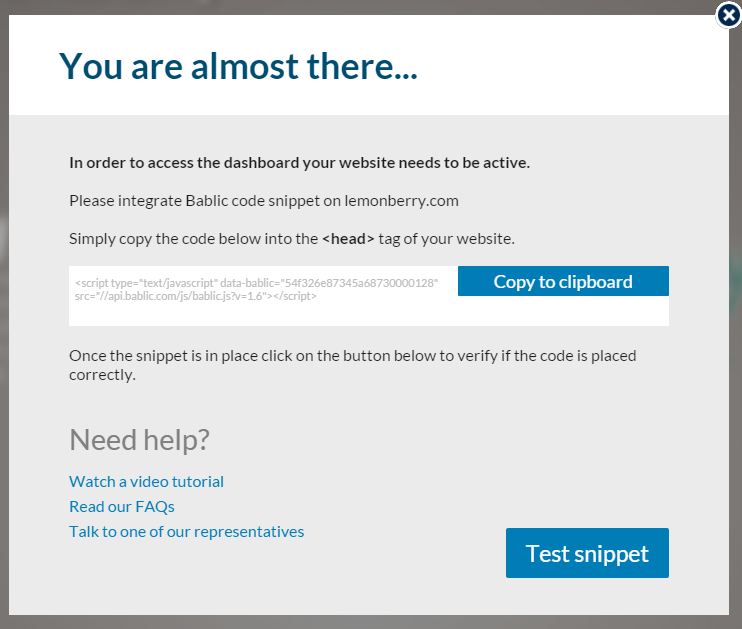
You can opt to have this automatically update all translated content as your original site is updated, so no need to log back in every time you publish a new blog post or add a new page. Very easy to get the hang of.
Now, let’s get down to localizing.
Getting Started
Your very first step is to add your site to Bablic’s Dashboard and Editor. This is as easy as inputting your URL, choosing your desired language and watching your site appear live on your screen.
The Bablic WYSIWYG Editor
The Bablic editor is actually a live version of your website – so any changes made elsewhere show up automatically. Navigation to inner-pages as well as all links work exactly as they would on your actual website, which is pretty great because it eliminates the confusion that often comes with site changes and having to navigate to backend editors and navigate back to preview pages.
Language & Location Widget
One of my favorite aspects of Bablic is the ease of customization when it comes to how your language and location options appear within the editor and eventually to users. Once you’ve input your site address and chosen which languages you would like to add, your selected languages will show up on a widget on the side of your dashboard.

This allows you to toggle between languages – a feature I really appreciate because I want to be able to compare changes in text and design across “sites” to see what works best.
You also have the ability to install the language widget that you see on your editor right onto your site, or you can choose a language menu. This gives your users the ability to choose whichever language makes them the most comfortable. Additionally, a browser language recognition feature is available in which the user’s language is served as the default language (if available).
The UX/UI
The biggest selling point on a service like Bablic is the ease of use for the laymen without a team of coding and design experts at hand. Bablic’s dashboard is pretty intuitive – for language, click on the language widget.
To change an element on your site, just right click on any element – that’s images, logos, text – to see your options. Once you’re in that editor pop-up, you can simply click on the right and left arrows (see example below) to move through all editable elements on a page.

Here’s something some of you will appreciate and some of you won’t.
Bablic recently limited design and CSS change capabilities to make changes load faster and to make possibilities more clear and less overwhelming. I personally appreciate this – I’m not sure I would know what changes to make beyond color, spacing, sizing and image uploads or location on page. If you want to go beyond this or install different capabilities, you’ll have to make those changes through your own website’s back-end.
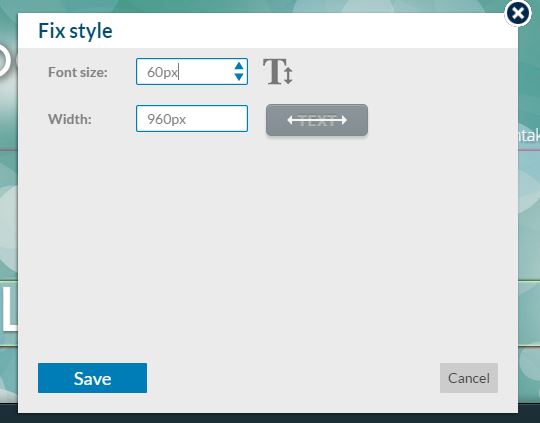
Editing Text
The ability to click on every element on your page and inspect it gives you complete control over every aspect of your site. For example, if you opt for machine translation on your site (more on that below) but want one word excluded on one page, you can easily click, pull down the current text and make any changes you want right on that page.
Editing Page Meta
From within the editor, you can also choose to edit your page’s meta data, including elements like tags and descriptions. This is essential for SEO and a great step for getting found in global search engines. Remember, your new tags need to not only be translated, but also relevant.
Languages & Translations
Translation
Although Bablic positions itself as much more than just a translation solution, translation is certainly a crucial aspect of localizing your site the right way.
You can choose up to 30 languages (including Yiddish, if that’s your thing) to translate from and into. And if you’ve noticed they’ve got a prominent language missing just submit a support request with the Bablic team, and if enough requests are received they’ll add it within the day.
Regardless of the plan you’re on you’ve got quite a few translation options, including: self-translation, machine translation, and custom professional translation. I’ll go over these options in the following three sections.
Machine Translation
When you enter the language that you wish to localize to, you can choose machine translation to automatically detect and translate all translatable content. As mentioned above, the really nice thing here is that after everything has been translated, you can go element by element on your site and either uncheck translation for that block/piece of content or edit within the dashboard editor to clean up any mistranslations, idiomatic phrases or industry terms you simply don’t want translated.
Machine Translation Opt-Out
You can also choose to opt-out completely from machine translation. If you or one of your team members speak the language, you can make the changes yourself at your own pace.
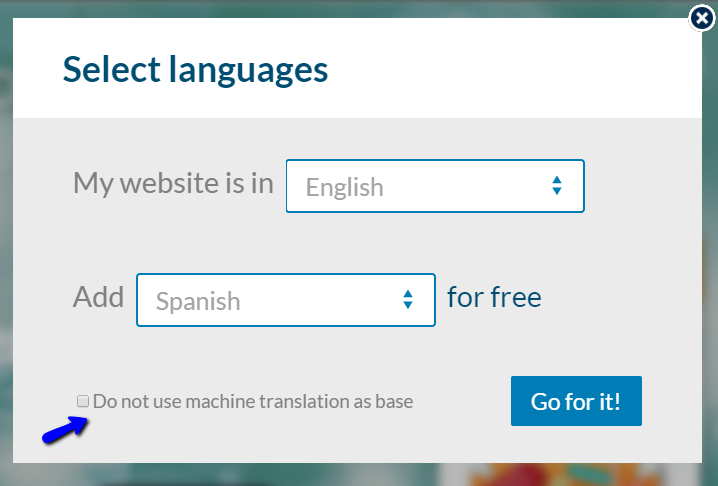
The beauty of the Bablic dashboard is that you can easily add collaborators so multiple team members or outside contractors can be signed in at the same time. These parties can be granted whatever user permissions/user priviliges you deem necessary (and you can view edits and changes in real time).
There also exists an option to export your text and send it over to a translator (I really love this easy export feature! See more on that below).
Professional Translation
Bablic also offers a high quality human translation option. You can simply choose which pages you want translated, their software scans the content and gives you a custom quote, and Bablic then sends it over to a team of vetted translation professionals (more on pricing options on this below).

Another nice feature is that from the quote pop-up, you can check off which pages you want translated and see the quote change in real time. This is a feature I think a lot of companies will appreciate – no need to hunt down and test qualified translation professionals or wait for a quote. It’s as simple as clicking and pressing send. When the pages are ready, they are automatically published to your site.
Overall, I’m a fan of the flexibility and support Bablic offers with translation. The automated translation version gives you the ability to translate most of your content in one go and cut the work and time required by at least half. After that, you might require an actual human translator to go in and make only small, idiomatic edits. Or, if you really hate the machine translation for a specific piece of content, you can easily disable that one piece and do it yourself.
As mentioned above, by installing Bablic’s plugin or snippet on your site, you also have the option to allow automatic translation as your site is being updated, meaning you can write a new blog post or edit your homepage in English and that change will automatically show up translated on your Spanish, German and French sites as well.
Bablic’s Dashboard
Statistics
Bablic takes the guess work out of choosing which languages and geographical areas for which to optimize.
Once you’ve installed the snippet or set up the plug-in through your CMS, your dashboard populates with important information you’ll need to know as you’re beginning your localization project.
Based on traffic from around the world, your dashboard shows you which languages youshould be adding to grab that low hanging fruit. If you’re not already monitoring traffic daily or have a dedicated SEO team, this is an excellent feature that can really help you close on traffic you are already seeing. I particularly appreciate the red zoned map they use – it gave me a different perspective on where my traffic is coming from and how those zones might relate to each other.
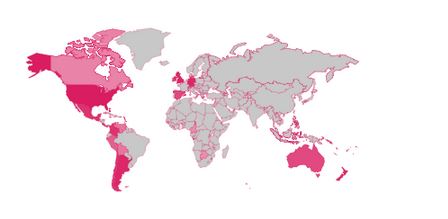
Important to note: Bablic allows you to manage multiple sites at once (more on that below) so you can compare traffic across your projects and see what may have worked with one site that you could apply to another.
Website Settings
Another aspect of Bablic that’s a clear win from the SEO (but not necessarily a tech master) perspective: from within the Bablic dashboard, you can specify what your language specific URLs will look like once you publish.
You can choose from subdomains, hashes (gap.com#de), query strings (gap.com?de) or even automatic browser language detection (glad to see Bablic recommends against this under that option, but to each his own!).

In terms of URL structure, Bablic permits you to implement customized subdomains for each region you’ve localized for. So, for example, if your website has been localized for the Chinese market, your URL can appear something like this: cn.example.com.
From experience, URL structures can be somewhat difficult to get streamlined from some CMS’s, and you particularly want your URLs to be clean and allow search bots to read and index them easily if your goal is to start getting found on new search engines in new languages and countries.
Overall – really pleased with this feature.
Languages
I’ve already mentioned adding languages within the editor above, but you can also choose to add and customize those languages from within the dashboard. Once you choose your language you can also customize date/time formats (e.g. in some countries month comes before day in the date).
Changing the language of one’s site can be an especially arduous task when you have to also change the layout and text direction. For companies looking to enter Arabic/Hebrew markets, this is often seen as one of the largest technical barriers because a complete redesign needs to take place (essentially you need to flip all of the content around). Bablic covers you in this department by flipping the structure of the website and placing content in the desired location.
Pages
This tab gives you a birdseye view of your site and the amount of work that needs to be done. From here, you can choose which pages to include or exclude from translation (or from existing at all on your translated site). You can also edit text as a list instead of clicking through element by element.
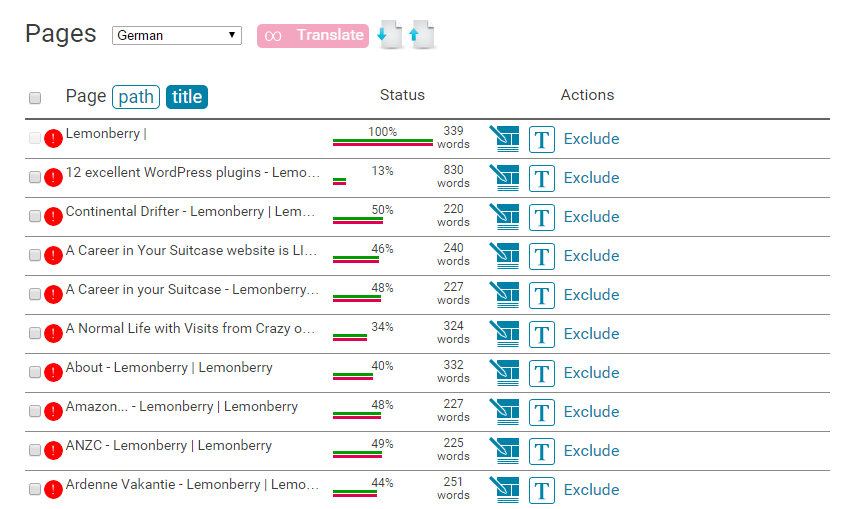
From here, you can also export content using any format (including XLIFF) which is really helpful if you’re going with an outside translation agency or a freelance translator. XLIFF (XML Localization Interchange File Format) is the preferred format for translators and other professionals in the localization industry.
This XML-based format standardizes the way localizable data is passed between tools, allowing elements and attributes from original content to be stored along with its corresponding translation so you don’t have to worry about content getting lost. Having the ability to send to outside contractors in XLIFF is essential for any localization project.
Collaborators
Bablic allows you to add collaborators to any project – letting multiple team members sign in and simultaneously make edits that can be seen in real-time. Bablic’s account structures make it a versatile tool for all kinds of users. SMBs in the middle of localizing their own content can include multiple team members or allow outside contractors access to a project, while agencies and freelancers can manage several clients and projects within their dashboards, streamlining processes and reducing the need for multiple accounts or payments. SEO agencies and translators would do well to consider Bablic as a tool to use with clients that are looking to transition globally.
CMS Compatibility
In theory, Bablic sounds great – but will this work on my site?
Bablic’s software is compatible with an impressive amount of CMS’s, including the e-commerce industry leaders like Shopify and Magento. It’s one thing to envision changing details on a simple site, but a translation/localization project that involves sites and databases with hundreds or thousands of pages and products that need individual tags and titles? An automated system means a heck of a lot of time and energy saved. (Trust me, I’ve spent weeks on the same site just translating hundreds of title tags – it’s a drag).

The only CMS that I’m aware of which isn’t compatible with Bablic is Wix, and this is because Wix doesn’t allow third-party localization solutions to run on their platform. In the event that you’re using Wix or another incompatible CMS, Bablic actively encourages you to reach out to your “provider” to get that changed.
Integrations & Plug-Ins
If your site is on WordPress, Drupal, or JOOMLA, Bablic makes sending and receiving live data between your CMS and the Bablic dashboard even easier with plug-ins you can install right from your CMS’s dashboard. Bablic has a step-by-step video tutorial for each of the CMS’ so there’s no room for confusion. On WordPress, for example, installing the plugin is as easy as signing into WordPress, going to the plugins tab, searching for Bablic and clicking install. No coding necessary.
And it should be noted that it’s Bablic’s intention to cover all major CMS’s and integrate with virtually every plugin imaginable. So stay tuned for future updates.
Database Compatibility
Essential for those with larger or more complicated sites: Bablic automatically connects and is compatible with databases, so you don’t have to worry about losing functionality or any data from forms or AJAX content. Additionally, Bablic interacts quite well with JavaScript.
The only thing Bablic cannot interact with is external components that are embedded as an iFrame and that sit on different domains. For example, think things like live chat services or integrating Facebook comments onto one’s website. In addition, Bablic does not interact with Flash and Java applets.
As a rule of thumb, Bablic can only integrate with content that sits on the same domain as the actual website.
Publishing
Publishing through Bablic is super easy once you’ve installed that snippet or set up the plugin mentioned above. There is a master publish/unpublish button that can push all content live when you’re ready, or you can choose to publish/unpublish each and every individual language, or even an individual page.
When you publish, Bablic creates a unique URL for each individual page based on the structure you chose in your site settings. Again, you have the option to choose how you want to structure your URL (subdomain, query string, hash, custom).
Bablic further provides users with an SEO boost by automatically generating XML sitemaps for you. If you’re not familiar with sitemaps, they are an essential feature for “working with” Google.
Your sitemap lays out all your URLs which Google can then read and understand. This allows the search engine to “visualize” how big your site is, and to understand the ranking of pages and their corresponding priority. When the Google bots understand and read your site, they index those pages, meaning they are now in Google’s directory and can be found in a search. Your title tags and content are also read, making sure any changes you make for SEO purposes won’t go to waste. This is especially necessary when you have multiple levels on your site due to multiple languages. When you serve Google a multilingual sitemap, they can better understand how your sites and languages work together. If you’ve never seen a sitemap, take a look at just a piece of one below.
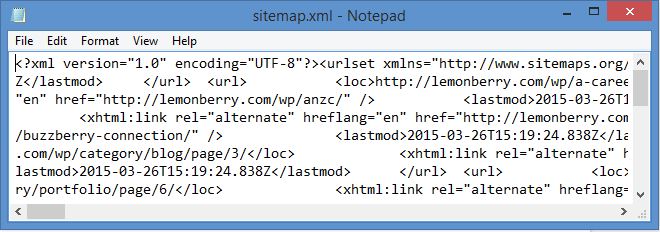
Pro vs Free Versions
If you only want to translate to one language and pay as you go with professional translation, the free version surprisingly lets you accomplish a good amount, but the pro versions offer a lot more flexibility with regard to languages, pageviews, SEO enhancements and guidance (for example, translating all meta content).
The paid plans start from as low as $15/month and don’t feature the Bablic logo on your website, which is good if you don’t want competitors to know your secret!
Billing
Bablic’s billing system works through pre-purchased credits (1 credit = 5-10 words depending on the language). This way you can pay for translation on-the-go and not have to log back in to give billing details every time you want to get another piece of content translated. This also helps smooth the automated translation process if you don’t want to specify every time you want a new piece of content translated but rather just want it to be done on the go.
In general, I like this system but if you have a budget and need to pick and choose where to allocate your resources, it might be tough to anticipate future costs when new content gets published. However, you don’t run the risk of going over budget without noticing – when your credits run out, the billing stops.
The Bottom Line
I’m really excited to see Bablic on the market – I think it’s time that SMBs take control of their own online content and not feel overwhelmed by changes that might seem too technical or projects that might seem too big.
Bablic empowers those businesses with less resources to grow their leads and conversions and explore the global market. I’m curious to know how Bablic holds up with bigger projects or with pro translation of languages that aren’t too common.
Ultimately, if it’s time for your company to go global, Bablic is a great place to start. Localizing your business should not be overwhelming. With Bablic, the world is just a few clicks away.
Top DiscoverCloud Experts



Interested in becoming a DiscoverCloud Expert? Learn more
Compare Products
Select up to three two products to compare by clicking on the compare icon () of each product.
{{compareToolModel.Error}}



































{{CommentsModel.TotalCount}} Comments
Your Comment